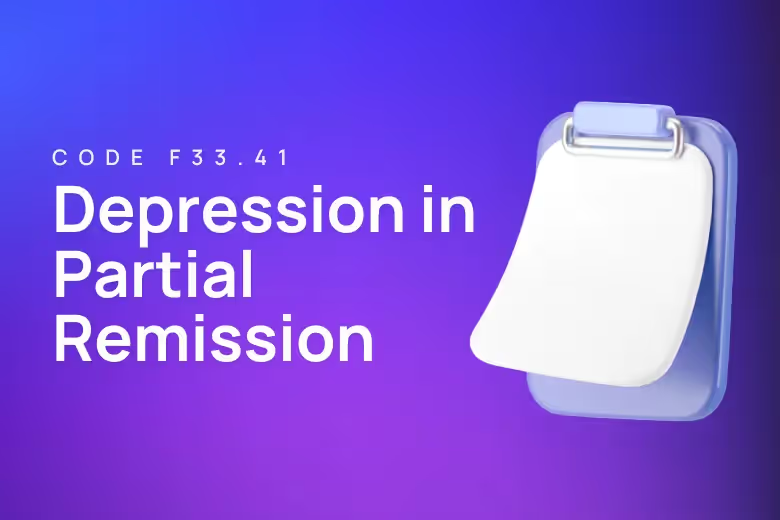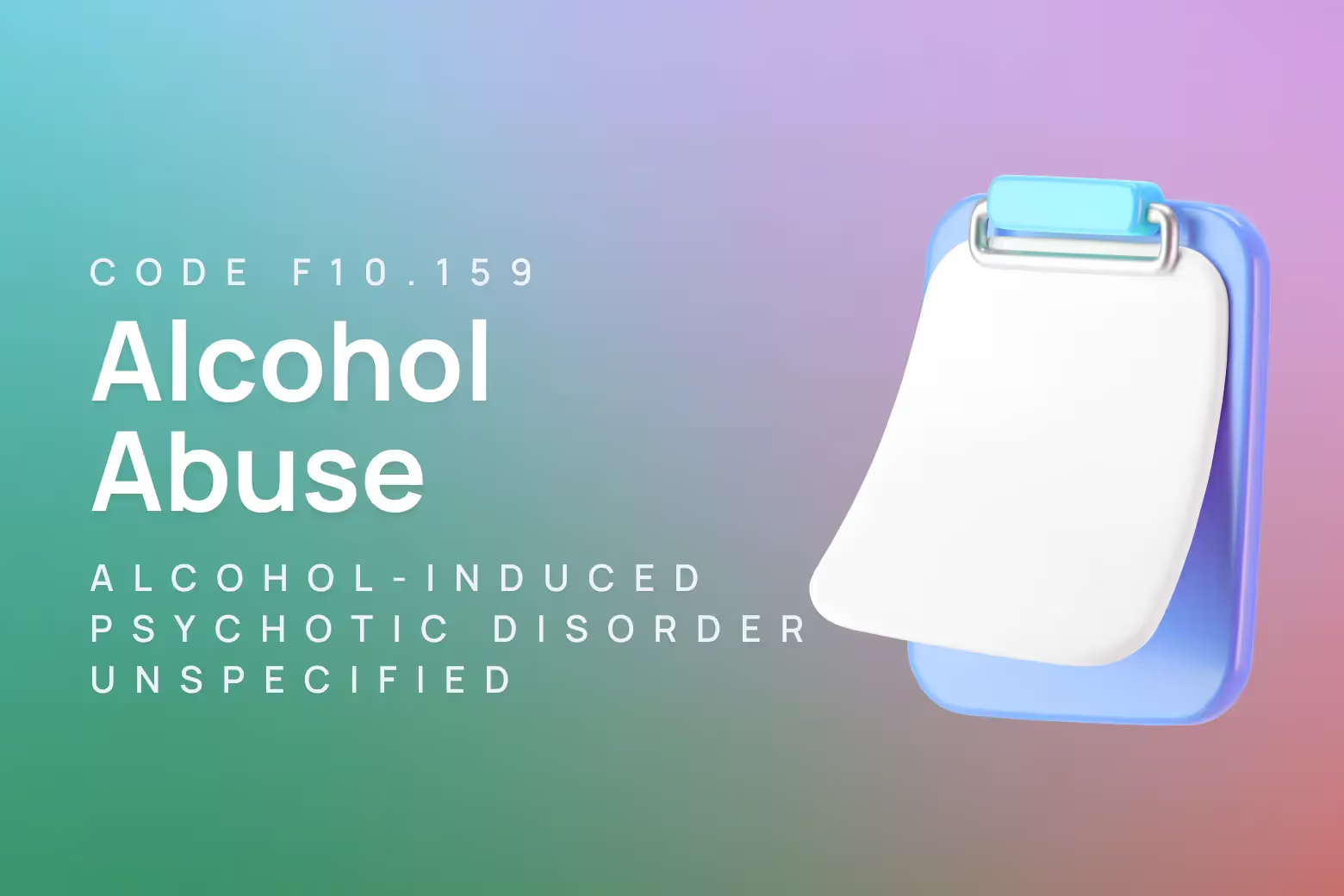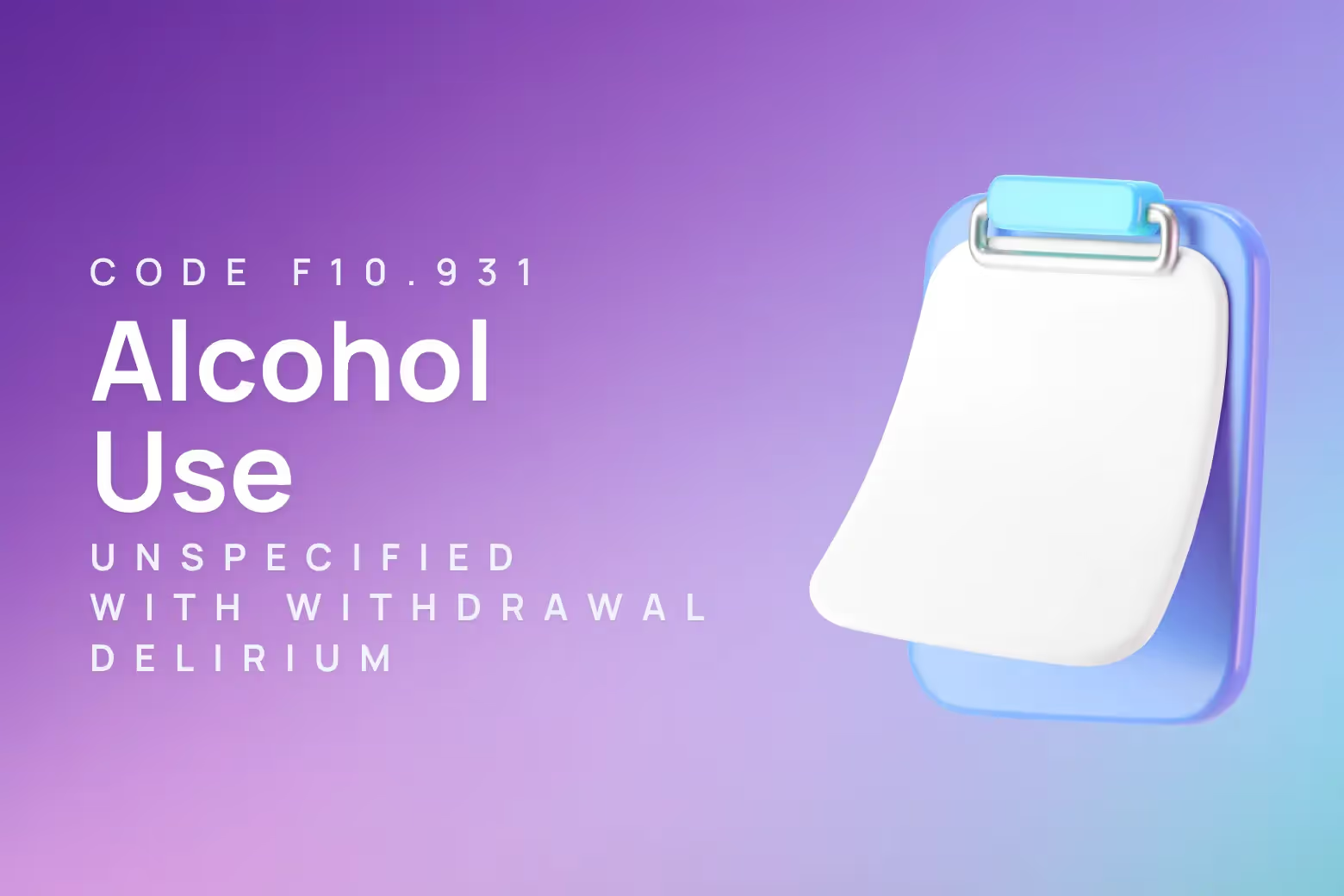ICD-10 code for alcohol abuse with unspecified alcohol-induced disorder

F10.19 is the ICD-10 code for alcohol abuse with unspecified alcohol-induced disorder.
This code captures cases where a client meets criteria for alcohol abuse and experiences an alcohol-related disorder, but the specific type of disorder isn't documented or determined.
Accurate diagnosis and coding help ensure appropriate treatment planning and proper reimbursement for services.
Key features:
- F10.19 applies when alcohol abuse causes a recognized disorder (cognitive, mood, anxiety, or sleep disturbances) but the specific disorder type isn't specified in documentation
- This code falls under the alcohol-related disorders category and requires evidence of problematic drinking patterns with associated psychological or physiological complications
- Proper differential diagnosis distinguishes F10.19 from alcohol dependence (F10.2x codes) and other alcohol-induced disorders with specified presentations
- Treatment typically combines psychotherapy approaches like motivational interviewing and CBT with appropriate billing codes based on session type and duration

Diagnostic criteria for alcohol abuse with unspecified alcohol-induced disorder (F10.19)
F10.19 requires documentation of both alcohol abuse patterns and evidence of an alcohol-induced disorder that hasn't been further specified. The abuse component involves repeated problematic use that causes significant impairment or distress.
Clinicians should identify a pattern of alcohol consumption that leads to failure to meet major obligations, use in physically hazardous situations, continued use despite social or interpersonal problems, or legal issues related to drinking. The "unspecified alcohol-induced disorder" component indicates the client experiences psychological or physiological complications from alcohol use beyond the abuse pattern itself.
The diagnostic criteria for alcohol use disorder include at least two of the following symptoms occurring within a 12-month period:
- Consuming alcohol in larger quantities or for longer durations than planned
- Persistent unsuccessful attempts to reduce or control drinking
- Spending considerable time obtaining, using, or recovering from alcohol
- Experiencing strong cravings or urges to drink
- Failing to meet important work, school, or home responsibilities due to drinking
- Continuing to drink despite recurring social or relationship problems caused by alcohol
- Abandoning important activities because of alcohol use
- Using alcohol in physically dangerous situations
- Drinking despite awareness of physical or psychological problems worsened by alcohol
- Developing tolerance (needing more alcohol for the same effect or experiencing reduced effects)
- Experiencing withdrawal symptoms or using alcohol to prevent withdrawal
The "unspecified alcohol-induced disorder" component means the client shows evidence of an alcohol-related mental disorder — such as mood disturbances, cognitive impairment, anxiety symptoms, or sleep problems — but the clinician hasn't documented which specific disorder is present.
When to use F10.19 diagnosis code
Understanding when to assign F10.19 versus other alcohol-related codes requires careful attention to the client's symptom presentation and the level of documentation available.
F10.19 vs F10.10 (Alcohol abuse, uncomplicated)
F10.10 applies when a client meets criteria for alcohol abuse without any additional alcohol-induced mental disorder. This code captures problematic drinking patterns that cause impairment but don't produce separate psychological complications.
Choose F10.19 when the client experiences an alcohol-related mental disorder alongside the abuse pattern, even if you haven't specified which disorder. F10.10 is appropriate when drinking causes life problems but hasn't triggered mood, anxiety, cognitive, or other mental health complications.
F10.19 vs F10.20 (Alcohol dependence, uncomplicated)
F10.20 indicates alcohol dependence without additional complications. Dependence involves more severe symptoms including strong physiological involvement, loss of control over drinking, and alcohol becoming a central life focus.
The distinction between abuse (F10.1x) and dependence (F10.2x) centers on severity and the presence of neuroadaptation. Clients with dependence typically show tolerance, withdrawal symptoms, and compulsive use patterns. Abuse involves harmful consequences without the same level of physical dependence or compulsive seeking behavior.
F10.19 vs specific alcohol-induced disorders
When you can identify the specific alcohol-induced disorder, use a more precise code instead of F10.19. For example, F10.14 captures alcohol abuse with alcohol-induced mood disorder, while F10.180 identifies alcohol abuse with alcohol-induced anxiety disorder.
F10.19 serves as a placeholder when clinical evidence suggests an alcohol-induced disorder exists but documentation doesn't support a more specific diagnosis. Consider whether additional assessment might clarify the presentation enough to warrant a more precise code.
Related ICD-10 codes
Understanding related codes helps ensure accurate diagnosis and opens opportunities for appropriate treatment planning:
- F10.10 - Alcohol abuse, uncomplicated
- F10.11 - Alcohol abuse, in remission
- F10.14 - Alcohol abuse with alcohol-induced mood disorder
- F10.150 - Alcohol abuse with alcohol-induced psychotic disorder with delusions
- F10.180 - Alcohol abuse with alcohol-induced anxiety disorder
- F10.181 - Alcohol abuse with alcohol-induced sexual dysfunction
- F10.182 - Alcohol abuse with alcohol-induced sleep disorder
- F10.188 - Alcohol abuse with other alcohol-induced disorder
- F10.20 - Alcohol dependence, uncomplicated
- F10.21 - Alcohol dependence, in remission
Interventions and CPT codes for alcohol abuse with unspecified alcohol-induced disorder
Treatment for F10.19 combines evidence-based psychotherapy approaches with appropriate medical monitoring when needed. Billing codes should reflect the actual services provided and time spent in therapeutic work.
Initial psychiatric evaluation
The first clinical contact establishes the diagnosis, assesses the alcohol-induced disorder, and creates a treatment plan. Use 90791 for comprehensive psychiatric diagnostic evaluation that includes history taking, mental status examination, diagnostic formulation, and treatment planning.
This initial assessment should explore drinking patterns, consequences, attempts to cut down, and symptoms of the unspecified alcohol-induced disorder. Document the diagnostic process thoroughly to support the F10.19 code selection.
Individual psychotherapy
Ongoing individual therapy addresses the core patterns maintaining alcohol abuse and helps manage the alcohol-induced disorder symptoms. Choose from these time-based codes:
- 90832 - Psychotherapy, 16-37 minutes
- 90834 - Psychotherapy, 38-52 minutes
- 90837 - Psychotherapy, 53+ minutes
Motivational interviewing works effectively as a first-line approach, particularly for addressing ambivalence about changing drinking behavior. This collaborative style helps clients explore their own reasons for change without confrontation.
Cognitive behavioral therapy serves as the most extensively researched treatment for alcohol-related problems. CBT sessions typically focus on identifying triggers for drinking, modifying beliefs about alcohol, developing coping strategies, and managing high-risk situations. The treatment gains strength when combined with motivational interviewing in early sessions.
Group therapy approaches
Group psychotherapy offers peer support and shared learning around alcohol-related issues. Bill 90853 for group psychotherapy sessions that focus on relapse prevention, coping skills development, or general support.
Group formats allow clients to learn from others' experiences, practice refusal skills, and build accountability. Groups work particularly well when combined with individual therapy.
Family involvement
When working with family members to address relationship dynamics or create supportive environments for recovery, use these codes:
- 90846 - Family psychotherapy without patient present
- 90847 - Family psychotherapy with patient present
Family sessions can address codependency patterns, communication issues, and family members' roles in supporting recovery. Including family strengthens treatment outcomes for many clients.
Screening and brief intervention services
For sessions focused primarily on screening and brief intervention rather than full psychotherapy, billing codes vary by payer:
Commercial insurance:
- 99408 - Screening and brief intervention, 15-30 minutes
- 99409 - Screening and brief intervention, over 30 minutes
Medicare SBIRT (non-preventive):
- G0396 - Structured assessment and brief intervention, 15-30 minutes
- G0397 - Structured assessment and brief intervention, over 30 minutes
Medicaid H-codes:
- H0049 - Alcohol and drug screening
- H0050 - Alcohol/drug brief intervention, per 15 minutes
Document the screening tool used (AUDIT, AUDIT-C, or similar), the score obtained, risk level identified, time spent, and brief intervention elements provided. Many payers restrict combining SBIRT codes with psychotherapy on the same day, so check payer-specific bundling policies.
Assessment instruments billing
When administering and scoring standardized screening instruments separately, consider 96127 for brief emotional/behavioral assessment, per instrument. This applies when scoring tools like AUDIT-C or other standardized measures as distinct services.
How Upheal improves F10.19 ICD-10 documentation
Clinical documentation platforms address many challenges clinicians face when managing alcohol abuse cases with unspecified induced disorders.
Suggesting appropriate ICD-10 codes based on session content
Upheal's clinical documentation platform analyzes session content and identifies relevant diagnostic indicators as clinicians work with clients. When alcohol-related symptoms emerge during sessions, the platform recognizes patterns consistent with abuse criteria and evidence of induced disorders.
The tool helps clinicians distinguish between uncomplicated abuse and cases involving additional complications. If a client describes mood disturbances, cognitive difficulties, or anxiety symptoms alongside problematic drinking, the platform flags these presentations and suggests considering codes that capture induced disorders.
This diagnostic support reduces the risk of using overly general codes when more specific ones better reflect the clinical picture.
Maintaining HIPAA-compliant records with proper diagnostic coding
Accurate diagnostic documentation serves both clinical and compliance purposes. Upheal creates secure, encrypted records that meet HIPAA standards while ensuring diagnostic codes align with documented clinical presentations.
The platform tracks symptom patterns across sessions, making it easier to identify when an unspecified induced disorder warrants further assessment. This longitudinal view helps clinicians notice when initial presentations evolve or clarify over time.
Proper coding documentation supports continuity of care if clients transfer providers or need referrals for additional services. Complete records with accurate codes communicate the full scope of alcohol-related complications to other treatment team members.
Reducing administrative burden so you can focus on client care
Documentation requirements for substance use disorders can consume significant time outside sessions. Upheal generates comprehensive progress notes that capture diagnostic criteria, treatment responses, and clinical observations automatically.
The platform handles billing code suggestions based on service type and session length, reducing manual work around CPT code selection. This automation helps clinicians spend less time on paperwork and more time delivering therapeutic interventions.
Faster documentation turnaround means better workflow efficiency. Clinicians can complete notes immediately after sessions rather than carrying documentation backlogs that create stress and increase burnout risk.
Supporting clients with alcohol abuse and unspecified induced disorders
Treatment for F10.19 requires addressing both the problematic drinking patterns and the psychological complications that accompany the abuse. Success depends on building strong therapeutic relationships while implementing evidence-based interventions.
Clinicians should assess motivation regularly and adjust treatment intensity based on client response. Some clients benefit from brief motivational work followed by more structured CBT approaches, while others need immediate coping skills training to manage high-risk situations.
The unspecified nature of the induced disorder creates opportunities for ongoing assessment. As treatment progresses, clinicians may gather enough information to warrant a more specific diagnosis that guides focused interventions.
Supporting recovery from alcohol abuse involves helping clients develop alternative coping strategies, repair relationships damaged by drinking, and rebuild daily routines around healthier activities. Documentation that accurately captures both the abuse pattern and associated complications ensures appropriate treatment planning and reimbursement.
Upheal's clinical documentation platform helps clinicians manage the complexities of alcohol-related diagnoses while maintaining focus on therapeutic work. By handling documentation tasks efficiently, the platform creates more time for the clinical relationship that drives recovery. Learn more about how Upheal supports behavioral health documentation at upheal.io.













